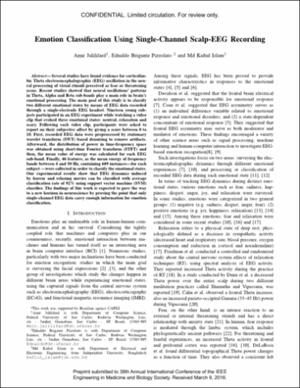Emotion classification using single-channel scalp-EEG recording

View/
Date
2016-10-18Author
Jalilifard, Amir
Pizzolato, Ednaldo Brigante
Islam, Md Kafiul
Metadata
Show full item recordAbstract
Several studies have found evidence for corticolimbic Theta electroencephalographic (EEG) oscillation in the neural processing of visual stimuli perceived as fear or threatening scene. Recent studies showed that neural oscillations' patterns in Theta, Alpha, Beta and Gamma sub-bands play a main role in brain's emotional processing. The main goal of this study is to classify two different emotional states by means of EEG data recorded through a single-electrode EEG headset. Nineteen young subjects participated in an EEG experiment while watching a video clip that evoked three emotional states: neutral, relaxation and scary. Following each video clip, participants were asked to report on their subjective affect by giving a score between 0 to 10. First, recorded EEG data were preprocessed by stationary wavelet transform (SWT) based denoising to remove artifacts. Afterward, the distribution of power in time-frequency space was obtained using short-time Fourier transform (STFT) and then, the mean value of energy was calculated for each EEG sub-band. Finally, 46 features, as the mean energy of frequency bands between 4 and 50 Hz, containing 689 instances — for each subject —were collected in order to classify the emotional states. Our experimental results show that EEG dynamics induced by horror and relaxing movies can be classified with average classification rate of 92% using support vector machine (SVM) classifier. We also compared the performance of SVM to K-nearest neighbors (K-NN). The results show that K-NN achieves a better classification rate by 94% accuracy. The findings of this work are expected to pave the way to a new horizon in neuroscience by proving the point that only single-channel EEG data carry enough information for emotion classification.
Collections
- Article [31]